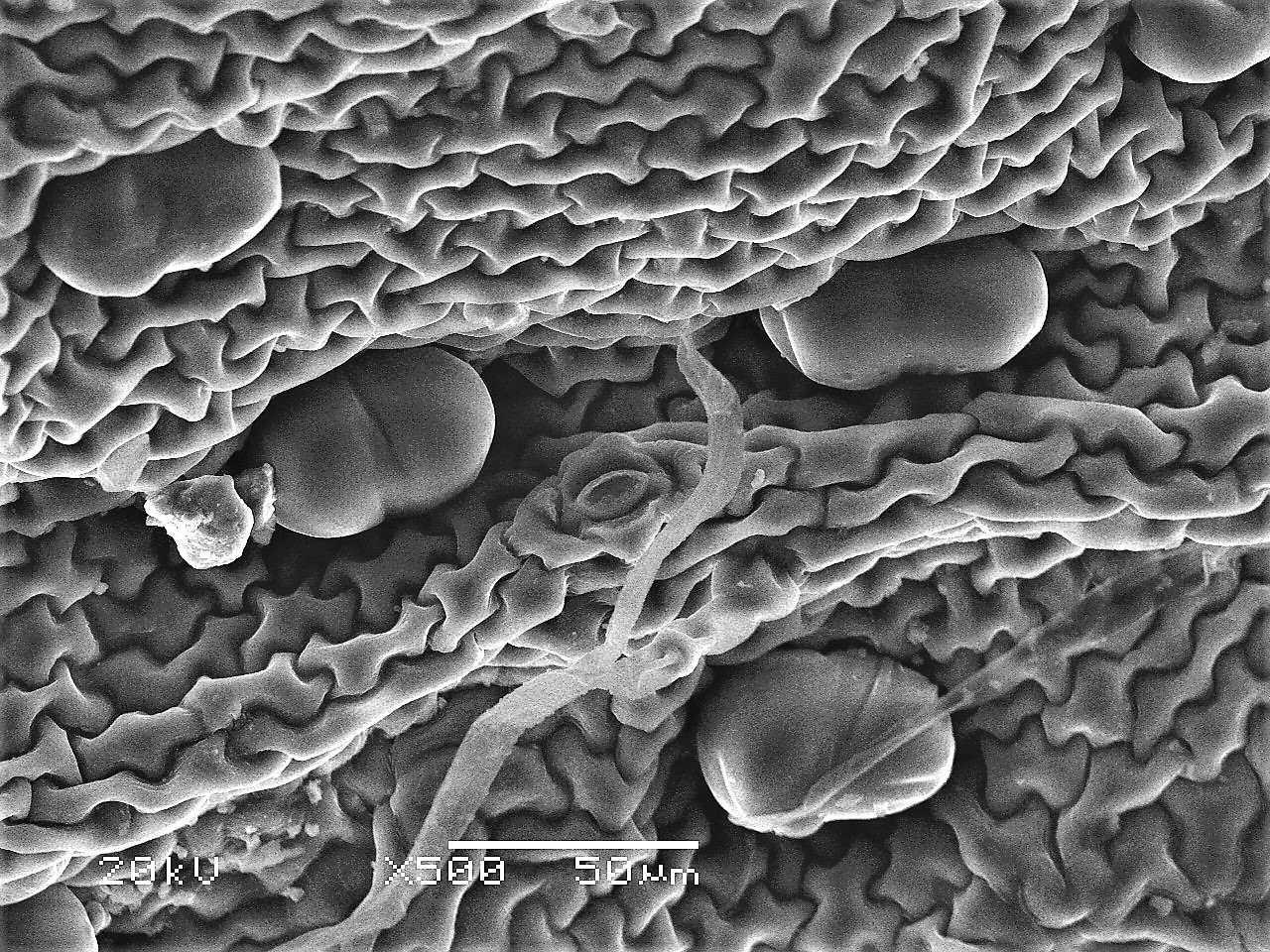Diagnostic micromorphological features of leaf surface of some Artemisia species (Asteraceae)
DOI:
https://doi.org/10.2478/hacq-2022-0012Keywords:
Artemisia, micromorphological features, leaves, light microscopy, scanning electron microscopyAbstract
The leaves of different species of Artemisia genus show considerable inner and external structural diversity. This paper presents a comparative study of the micromorphological features of leaf surface for seven species from different regions of Ukraine: A. absinthium L., A. annua L., A. dracunculus L., A. marschalliana Spreng., A. vulgaris L., A. argyi H.Lév. & Vaniot, and A. verlotiorum Lamotte. The vegetative organs of these plants have potentially significant value as medicinal raw materials. This study was carried out using both light and scanning electron microscopy. The main diagnostic characteristics for each species—in terms of form and structure of epidermal cells, stomata, trichomes, and glandules—were described and illustrated. Using combinations of selected qualitative micromorphological characteristics of the investigated species of Artemisia, it is possible to detect the species identity of these raw materials.
Downloads
References
Appezzato-da-Glória, B., Hayashi, A.H., Cury, G., Soares, M.K.M., Rocha, R. (2008). Occurrence of secretory structures in underground systems of seven Asteraceae species. Journal of the Linnean Society. Botany, 157:789–796.
Bini Maleci, L. & Bagni Marchi, A. (1983). «Artemisia vulgaris» L. ed «A.verlotiorum» Lamotte: studio di alcuni caratteri morfo-anatomici distintivi delle duespecie. Webbia, 37(1), 185–196. https://doi.org/10.1080/00837792.1983.10670272
Carnat, A. P., Chalchat, J.-C., Fraisse, D., Lamaison, J.-L. 2001. Chemical composition of the essential oil of Artemisia verlotiorum Lamotte growing in Auvergne (France). Journal of Essential Oil Research, 13(5), 336–339. https://doi.org/10.1080/10412905.2001.9712226
Cui, Z., Huang, X., Li, C., Li, Z., Li, M., Gu, L., Gao, L., Liu, D., Zhang, Z. (2020). Morphology, distribution, density and chemical composition of glandular trichomes in Artemisia argyi (Asteraceae). International Journal of Agriculture and Biology, 1-7. https://doi.org/10.17957/IJAB/15.1445
Derzhavna Farmakopeya Ukrainy (2016). / Derzhavne pidpryyemstvo “Naukovo-ekspertnyi farmakopeynyit sentr”. Second ed. Addition 1. Kharkiv, p. 214-216) [Державна Фармакопея України (2016. / Державне підприємство “Науково-експертний фармакопейний центр”. 2-е вид. Доповнення 2. Харків: c.214-216].
Duke, V.M., Paul, N.R., Elsohly, N.H., Sturtz, G., Duke, O.S. (1994). Localization of artemisinin and artemisitene in foliar tissues of glanded and glandless biotypes of Artemisia annua. International Journal of Plant Sciences, 155:365–372.
Ferreira, J. F.S., Anick, J. (2009). Annual Wormwood (Artemisia annua L.). New Crop Fact Sheet, 1–9. from https://hort.purdue.edu/newcrop/CropFactSheets/artemisia.pdf
Hayat, M.Q., Ashraf, M., Khan, M.A., Mahmood, T., Ahmed, M., Jabeen, S. (2009a). Phylogeny of Artemisia L.: Recent developments. African Journal of Biotechnology, 8, 2423–2424.
Hayat, M.Q., Ashraf, M., Khan, M.A., Yasmin, G., Shaheen, N., Jabeen, S. (2009b). Diversity of foliar trichomes and their systematic implications in the genus Artemisia (Asteraceae). International Journal of Agriculture and Biology, 11, 542–546.
Hussain, A. (2019). Distribution and Molecular Phylogeny of Artemisia Plants from Gilgit-Baltistan, Pakistan. Ph.D. Thesis, University of International Islamic University Islamabad, Pakistan, March, 69-70, Reg. No. 31-FBAS/PHDBT/F14. from http://prr.hec.gov.pk/jspui/handle/123456789/11070
Karbalaei, Z., Akhavan Roofigar, A., Balali, G. R., & Bagheri, A. (2021). Foliar micromorphology of some selected species of the genus Artemisia and its taxonomic implications. Rostaniha, 22(2), 273-285.
Kondrateva, E.V. & Kondrateva, H.K. (2010). Osobennosty anatomycheskoho stroenyia lystev y tsvetkov nekotorykh vidov polyni. Tykhookeanskyi medytsynskyi zhurnal, 2, 78-81. [Кондратьева Е.В., Кондратьева Г.К. (2010). Особенности анатомического строения листьев и цветков некоторых видов полыни. Тихоокеанский медицинский журнал, 2: 78-81.]
Ivănescu, B., Miron, A., Lungu, C. (2015). Histo-anatomy of vegetative organs of some Artemisia species. Revista medico-chirurgicala a Societatii de Medici si Naturalisti din Iaşi, 119, 3, 917-924.
James, C.M., Wurzell, B.S., Stace, C.A. (2000). A new hybrid between a European and a Chinese species of Artemisia (Asteraceae). Watsonia, 23:139–147.
Minarchenko, V.M. (2011). Medicinal plants of Ukraine: diversity, resources, legislation. Medicinal Plant Conservation Newsletter, (Ottawa, Ontario, 14 February 2011) 7–13. from http://cmsdata.iucn.org/downloads/mpc_14_1.pdf
Minarchenko, V.M. (2005). Medicinal vascular plants of Ukraine (medical and resource value) - K.: Phytosociocenter, 147–149. [Мінарченко В.М. Лікарські судинні рослини України (медичне та ресурсне значення) – К.: Фітосоціоцентр, (2005.– С.147-149].
Mosyakin, S.L., Fedoronchuk, М.М. (1999). Vascular plants of Ukraine. A nomenclatural checklist. Kyiv: 345 pp. from https:// dx.doi.org/10.13140/2.1.2985.0409/
Mosyakin, S.L., Boiko, H.V., Hlukhova, S.A. (2019). Artemisia verlotiorum (Asteraceae) u kontynentalnii chastyni Ukraini: teper i v Kyievi. Ukrainskyi botanichnyi zhurnal, 76(1), 3–8. [Мосякін С.Л., Бойко Г.В., Глухова С.А. 2019. Artemisia verlotiorum (Asteraceae) у континентальній частині Україні: тепер і в Києві. Український ботанічний журнал, 76(1), 3–8.]
Nigam, M., Atanassova, M., Mishra, A. P., Pezzani, R., Devkota H. P., Plygun, S., Sharifi-Rad, J. (2019). Bioactive Compounds and Health Benefits of, Artemisia Species. Natural Product Communications, 14,7. https://doi.org/10.1177/1934578x1985035
Ochirova, K., Krylova, E., Pautova, I. (2015). The variability of the leaves structure of Artemisia absinthium (Asteraceae). Biological Communications, 1, 4–14. from https://biocomm.spbu.ru/article/view/427.
Xiao, L., Tan, H., Zhang, L. (2016). Artemisia annua glandular secretory trichomes: the biofactory of antimalarial agent artemisinin. Science Bulletin, 61,26. https://doi.org/10.1007/s11434-015-0980-z

Downloads
Published
How to Cite
Issue
Section
License
Copyright (c) 2022 ZRC-SAZU

This work is licensed under a Creative Commons Attribution-NonCommercial-NoDerivatives 4.0 International License.
Authors guarantee that the work is their own original creation and does not infringe any statutory or common-law copyright or any proprietary right of any third party. In case of claims by third parties, authors commit their self to defend the interests of the publisher, and shall cover any potential costs.
More in: Submission chapter












